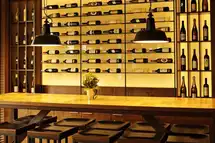What is new restaurant technology?
Today's restaurants are using a variety of new technologies to improve the dining experience for their customers. Some of these include- -Tablets for ordering and paying- Customers can use tablets to order their food and pay their bill without having to wait for a server. -Self-service ordering kiosks- These kiosks allow customers to place their order and pay for it without having to wait in line. -Digital menu boards- These menu boards make it easier for customers to see what's available and make their selections. -Online reservations- Customers can now make reservations online, which helps restaurants better manage their seating.
New Restaurant Technology- 5 Automation Ideas for the Profit-Oriented Kitchen
What's Kitchen Automation?

It may sound like something out of The Jetsons, but technologies once considered pure science fiction are now central to both, the commercial and the domestic kitchen.
Kitchen automation is the term for it. It refers to tech that automates mundane tasks in the kitchen -- from keeping track of supplies, managing inventory, to preparing complete meals. Some may believe that automation takes away from the joy of cooking. But it can actually free up time and make some tasks more efficient, and therefore, all the more enjoyable.
Kitchen automation integrates technology with kitchen appliances to make cooking faster and easier, especially in a chaotic environment of commercial kitchens. Automatic dishwashers, ovens with sensors, and cooktops controlled by a centralized computer system, all come under this umbrella. Kitchen automation can also refer to features such as hands-free faucets, sensor-activated garbage cans, and smart refrigerators that automatically order groceries when stocks run low.
Why is Kitchen Automation Such a Hot Topic These Days?
The effects of labor shortage are far-reaching, and one sector that keenly feels the brunt of it is the restaurant industry. Often seen as toxic, unregularized, with no fixed hours or schedules, job openings in the restaurant sector in the United States increased from 5.8 to 8.4%, according to a US Labor Statistics Bureau report published in May 2022.
The restaurant industry has struggled to find enough workers to fill positions, leading it to experiment with automation to compensate for the shortfall. Some restaurants have replaced human employees with robots that can cook and serve food, while others are using technology to automate tasks like taking orders or making payments by employing artificial intelligence-led systems.
In fact, in the aftermath of the pandemic, automated restaurant technology solutions have helped the industry cope with many acute problems. From managing social distancing norms with AI systems at drive-thrus, to online ordering and third party delivery to reduce labor involvement, everything has helped reduce costs and increase efficiency. Technology like self-service kiosks that integrate with POS systems, digital menus, prepackaged meals, automated dishwashers, QR codes for payments, and robotic arms to prepare food quickly and accurately have come in handy.
Restaurant Automation can speed up production while maintaining quality control (yes, automated systems can also help eliminate human error in portioning or temperature-control tasks). This is especially important in high-volume kitchens where small mistakes can have big consequences. In addition, by reducing the need for cooks to handle potentially hazardous equipment, commercial kitchen automation also reduces the risks of accidents and injuries in the workplace.
Arguments around automation are still brewing. Some see this as a necessary evil; others worry it will lead to even fewer jobs for humans in the long run. But as labor becomes more scarce and expensive, the foodservice industry struggles under immense pressure to increase productivity and efficiency. As a result, automation in commercial kitchens (and debate around it) will likely continue. Meanwhile, restaurants embracing new technology trends are witnessing improved efficiency and safety throughout their operations.
Let's look at a few technology trends helping restaurants ease the pressure.
Dated equipment leads to inefficiencies and higher costs.
Automation can help streamline your kitchen, improving profits.
5 Kitchen Automation Ideas Making Headlines- No. 1- Robot Chefs
Smart, agile, and precise -- robot chefs are quickly redefining what's possible in commercial kitchens. From perfecting delicate sauces and cutting a variety of pasta, to simplifying the Pizza Making process, these machine culinary artists are changing the way we think about food preparation.
Most commercial kitchens have functioned for the longest time with human chefs. From preliminary preparation to final execution, they handled every step of the cooking process. However, with robots making some of the cooking easier, machines are becoming more common in commercial kitchens. These robot chefs can perform various tasks, such as chopping vegetables, measuring ingredients, and cooking food. They have helped redefine the way commercial kitchens operate.
Robots have become particularly useful after the pandemic, with the Restaurant Industry facing an acute staff shortage. (The U.S. Bureau of Labor Statistics 2022 report flagged that the year-on-year quit rate in the restaurant industry jumped from 4.8% to 6.9%, more than any other sector. That is when the hiring rate has been steady at 8.1%.)
Robot chefs are taking the pressure off restaurant staff by automating work. Miso Robotics' automated kitchen assistants, Flippy and Slippy, help with grilling, frying, and drink-filling. Cecilia.ai's Cecilia mixes drinks, while interacting with customers. Chipotle's robotic kitchen assistant, Chippy, cooks tortilla chips. The list is long, and more additions are being made.
While some may see robots as a threat to traditional kitchens and chefs, the reality is that they offer a new set of advantages and capabilities. These automated machines work for hours on end without ever taking a break. Most of them are also equipped with advanced sensors that allow them to make real-time adjustments to recipes based on factors like temperature and ingredient quality.
In many ways, robot chefs are simply an extension of the longstanding trend toward automation in the foodservice industry. They can free up human workers for more creative tasks like menu development or customer service. So there's a high likelihood of seeing more of them in commercial kitchens in the years to come.
Kitchen Automation Idea No. 2- Automatic Ingredient Dispensers
As anyone who's worked in a professional kitchen can attest, prepping ingredients for dishes is one of the most time-consuming and tedious tasks. However, it's also one of the most important, as even a small mistake can ruin an otherwise perfect meal. This is where automatic ingredient dispensers come in handy.
No one who spends time cooking can deny having wished for an easier way to measure ingredients. Automatic ingredient dispensers can measure ingredients easily and accurately, so one doesn't have to worry about making mistakes when measuring for recipes. These devices are designed to streamline the ingredient prep process by automatically measuring and dispatching the correct quantity of each ingredient. They thus save time and reduce the chance of human error, resulting in more consistent dishes and less food wastage.
What's more, many modern automatic ingredient dispensers come equipped with features like built-in scales and touchscreens that make them even easier to use. Some models also allow users to create custom recipes that can be stored and recalled at the touch of a button.
When it comes to convenience in the kitchen, few appliances can match an automatic ingredient dispenser. Take, for instance, Rosseto's bulk dispenser. It releases spices and dry ingredients with precise measurements. The Orange Chef Prep Pad- Smart Food Scale is another great option that streamlines the cooking process. It connects to an app on your smartphone or tablet, which allows you to select a recipe and add the necessary ingredients with just a few taps. In addition, the scale automatically adjusts to the correct measurements.
Whether you're a Michelin-starred chef or a home cook who wants to make life in the kitchen easier, automatic ingredient dispensers are worth considering.
Kitchen Automation Idea No. 3- Kitchen Display System
A kitchen display system (KDS) is a computerized system consisting of a touchscreen display mounted in the kitchen, and integrated with various software applications. It streamlines food preparation and delivery.
KDS can be used for ordering, menu management, ingredient tracking, quantity control, and waste reduction. In some cases, KDS systems are also equipped with features to help chefs remotely monitor multiple cooking stations simultaneously. It allows them to view all incoming orders on an easy-to-read screen placed at a restaurant point of sale or POS system, self-service kiosk, or both, eliminating the need for paper tickets. As a result, commercial kitchens can operate more efficiently with less confusion and wasted motion.
New versions of the KDS also give specific instructions for each dish, like the addition or removal of certain ingredients the customer requests. This information is sent directly to the kitchen staff. The KDS also provides timers and other alerts to ensure that each dish is cooked correctly and served fresh. In addition to saving time, kitchen display systems can also help reduce waste in commercial kitchens. By centralizing all the information about each order, chefs can easily identify which ingredients need to be used and how much of each ingredient is needed. This helps avoid over-ordering or preparing too much food, which can lead to significant food waste. Ultimately, a KDS improves communication between the front of house and back of house staff and increases efficiency.
Restaurant owners are struggling to keep up with the competition.
Implementing new automation technologies in the kitchen is one way to stay ahead of the curve.
Kitchen Automation Idea No. 4- Temperature Monitoring System

A commercial kitchen can't function without a well-functioning temperature monitoring system. This crucial technology helps ensure that food is safe and helps improve energy efficiency by regulating heating and cooling levels. Automating temperature control with devices like thermostats and sensors can help to ensure that your kitchen is always operating under favorable conditions.
Temperature monitoring systems keep a restaurant business running smoothly. For example, they tell you when to move your food before it spoils so you don't have to throw it out. You also don't need to worry about messing up your schedule because there won't be any interruptions to your operations due to faulty equipment. Automated temperature monitoring systems report and alert managers in real time about any temperature discrepancy in the unit, which can prevent disastrous outcomes.
Some of these systems allow cooks and kitchen staff to monitor the overall temperature of the kitchen. If the temperature in any part of the kitchen falls below the safe level, an alarm will sound at the station. The kitchen staff can then identify the problem immediately and take corrective action before contamination sets in.
Temperature monitoring systems play a critical role in ensuring food safety in commercial kitchens by constantly measuring and logging the temperatures of food items and storage areas. By law, all TMSs implemented must meet food safety standards laid out by government agencies such as the Food and Drug Administration (FDA) to ensure protection against bacteria that can cause food poisoning. Some common features of the new-age TMS include automatic email alerts that notify managers when unsafe temperatures have been logged, and scheduled reporting, which creates log files that can be easily stored for future reference.
Kitchen Automation Idea No. 5- Automatic Trash Compactors

Restaurant Technology has revolutionized the way kitchens operate. Automatic trash compactors are just another addition to the many automated technologies helping commercial kitchens. Commercial kitchens typically produce a lot of waste, including food scraps and packaging materials. By compressing waste into a smaller volume, trash compactors help reduce the amount of space needed to store waste. They can help improve the overall efficiency of a kitchen and reduce waste storage costs.
Compressing trash can reduce its volume by up to 80%, making it easier for the kitchen staff to handle and dispose of garbage. These compactors help reduce the eco-footprint by taking up less space in landfills. They keep kitchens clean, tidy, and organized too. Select models also offer an air freshener option or a compartment with charcoal filters. In addition, they help reduce the time staff members spend on waste management and reduce the risk of injuries associated with the manual handling of waste.
New restaurant technology can be expensive and difficult to implement.
Automation can help restaurants improve efficiency and profitability.














































































































